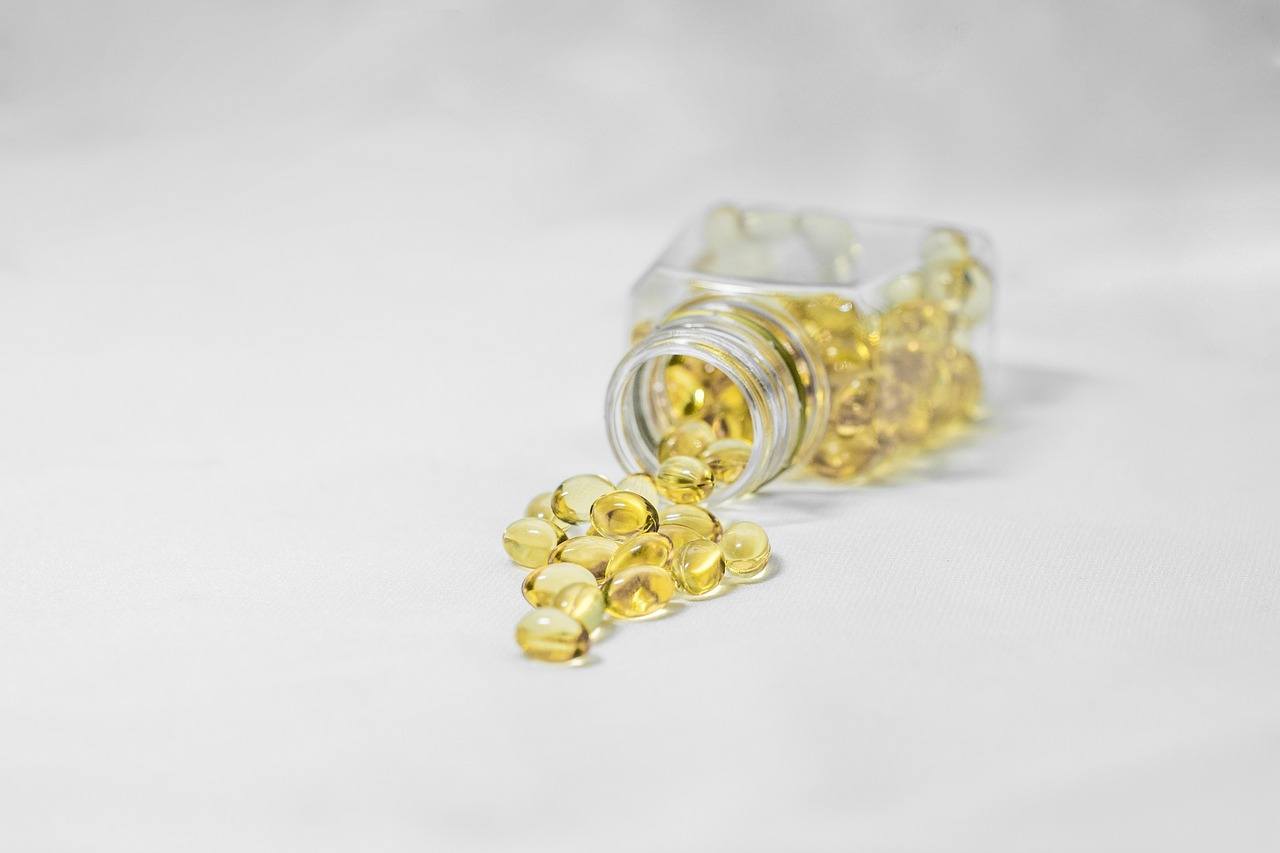You probably came to this page because you wonder if Shaklee is a scam, pyramid scheme, or a legit opportunity.
No need to worry you’re in the right place.
Over the last few years, I’ve been busy creating reviews about all kinds of online products.
Some turned out to be fake others were legit ways to make money online but in the process, I learned how to spot scams.
In this post, I’m going to look at Shaklee’s products, history, income statements, and compensation plan to find out if Shaklee is legit or a scam.
Shaklee Review Overview
Name: Shaklee
Website: shaklee.com
Founder: Roger Barnett
Product Type: Health and Wellness MLM
Earning Potential: Low
Risk: Low
Price: $49 + Extra costs (Detailed explanation below)

Summary:
Shaklee is a company that’s known for producing the first multi-vitamin. They distribute nutritional supplements, bath and body care, and household products.
I don’t consider their MLM program a pyramid scheme or a scam but looking at the numbers on their income disclosure it’s at least a bad business opportunity for most people.
In my post, I do a deep dive into how much it’ll cost (including hidden costs) and how much the majority of Shaklee ambassadors earn in a year.
Similar to: Yoli MLM, Pruvit MLM, Amsoil MLM, Bellame MLM, doTERRA MLM, VeloVITA MLM, USANA MLM
Recommended: No
Interested in learning how to earn money online
without recruiting or reselling products?
READ THE NEXT BLOG POST:
What is Shaklee?
The Shaklee Corporation (or short, Shaklee) is a health and wellness company founded in 1965 by Forrest C. Shaklee and his 2 sons. The company is in the business of distributing nutritional supplements, beauty, and household products.
The first Shaklee product however was created a long time before that in 1915 was a vitamin. They named it Shaklee’s Vitalized Minerals. It was the first multivitamin produced in the United States.
In 1961, Shaklee releases a product called instant protein after which they started to get a lot of attention in sports.
They even became the US Ski team’s official nutritional consultant for the Olympics.
In 1982, Shaklee became a Fortune 500 Company.
Beginning in 1993 and through the end of the NASA shuttle program, Shaklee provided NASA with a customized version of its rehydration beverage, Performance, under the name Astroade for use by Shuttle astronauts.
Shaklee Corporation was a publicly traded company from the late 1970s until the spring of the year 2000 when Shaklee became a privately held company through its acquisition by Yamanouchi Pharmaceutical.
In the 2000s, it also became the first company with a climate-neutral certification and is still in business to this day.
How does Shaklee work?
Shaklee is a company that distributes health and wellness products primarily in the form of nutritional supplements. Instead of directly selling it to consumers they have chosen to use the MLM model which gives you the choice to earn money by:
- Selling the products for a commission
- Recruiting people to earn bonuses.
- Mentoring other ambassadors
What is MLM?
MLM (a.k.a network marketing or direct selling) stands for multi-level marketing.
According to Wikipedia, multi-level marketing is a marketing strategy for selling products or services where the revenue is derived from a non-salaried workforce.
As a part of this workforce, you sell the products from the company, and/or recruit people to do the same thing. This group of people you recruit will work under you and is referred to as your downline.
The bigger your downline is the more money you can earn passively (technically speaking) because you’re getting paid a percentage based on the performance of your downline.
This also means the person that recruited you which is called your upline is making money based on your performance.
The act of recruiting turns an MLM company into a pyramid-shaped organization where the first people to join make the most and are on the top of the pyramid and those last to join are at the bottom.
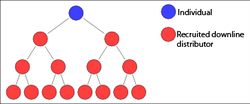
Source: Wikipedia
MLMs have been around for a long time. There are Multi-level marketing companies active today that were founded in the 1950s. MLM has a lot in common with pyramid schemes, so scammers often use MLM to disguise their pyramid schemes.
Is it absolutely necessary to recruit people? No.
You can also stick to just selling products you can order at wholesale price (25% discount) and re-sell to make a profit. This is easier said than done for multiple reasons which is why most members try to recruit others so they can earn more money.
How to join Shaklee
Most people get referred to Shaklee but you can also sign-up through their website.
You’ll have the option to become a regular Shaklee member or an Ambassador.
Shaklee members
Shaklee members get a 15% discount on their personal purchases and Free shipping on orders over
$150 and $8.99 flat-rate shipping on everything else.
They also have the capability to receive loyalty rewards in the form of 15% cashback on all products purchased.
Shaklee ambassadors
Are independent distributors that share Shaklee products. Shaklee Ambassadors may sell Shaklee products, earn bonuses, and sponsor others into Shaklee. This is the MLM program, Shaklee.
After signing up on the website, you can become a Shaklee ambassador by following these 4 steps.
Step 1: Purchase a starter kit
Step 2: Acquire Autoshipping (optional)
Step 3: Sign Shaklee’s agreement
Step 4: Start Sharing and Earning
Step 1: Purchase a starter kit
You can choose between 2 starter kits
1. Business Starter Kit $49.95
Includes: The essential business tools: Personal Website (PWS) to get selling, mobile apps to manage your business, samples to share with family, and support and training.
A sample credit to share via the Shaklee Share App (expires 30 days from the join or
upgrade date).
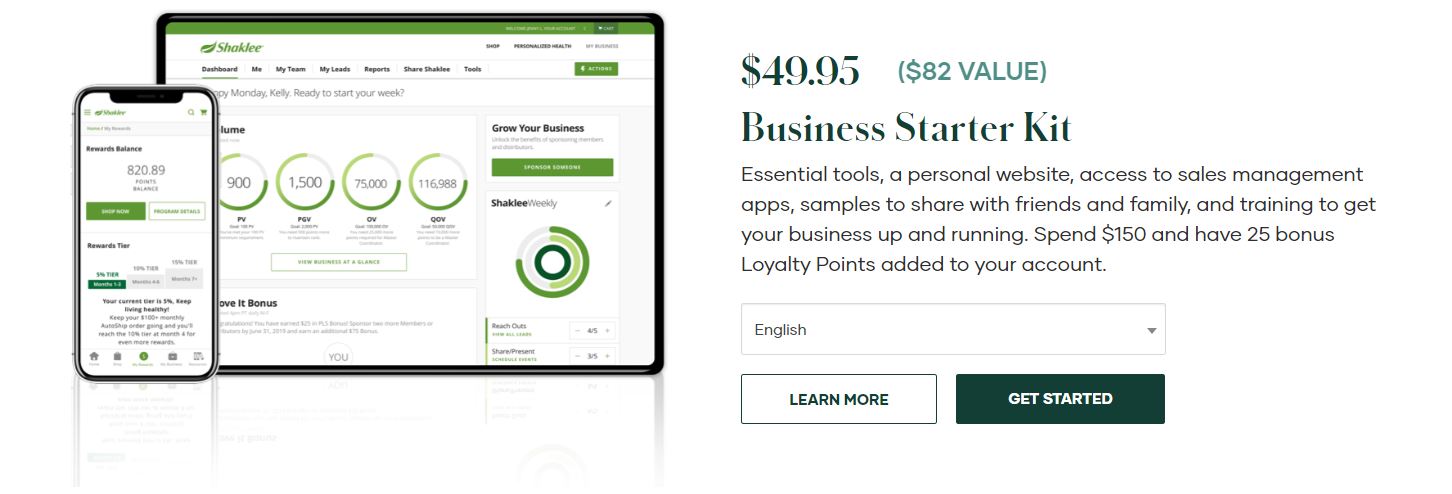
A Business Starter Kit $10 off coupon to share with a potential new Ambassador
The website costs are included for the first 3 months. After that, you’ll need to pay $14,95 per month to keep your personal website.
2. Ready Set Wellness Bundle $179+$49.95
Includes free shipping, and 25 bonus Loyalty Points on your next purchase and you can choose the samples you receive.
The kit also includes everything that’s in the Business Starter Kit
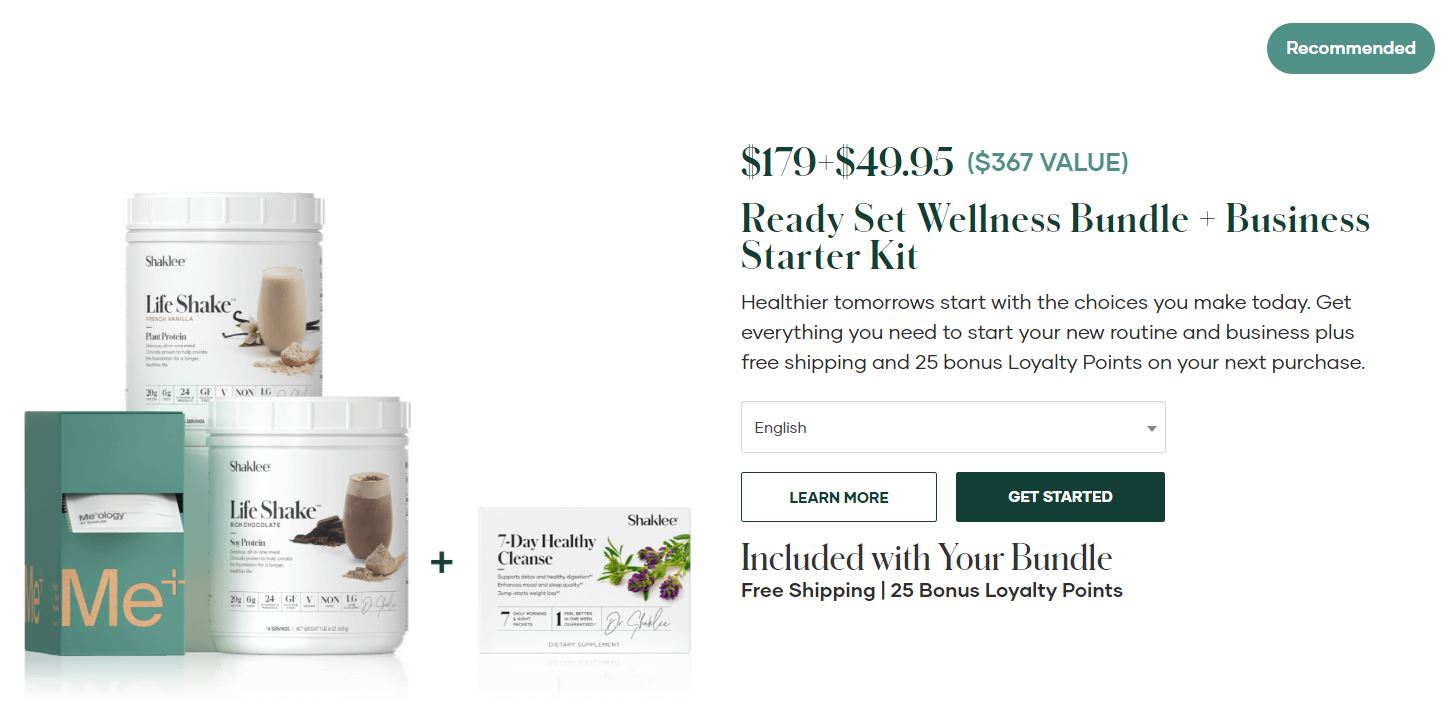
Step 2: Acquire Autoshipping (optional) or Boosters
These are optional bundles that you can purchase with a 30% discount.
Auto shipping grants you an additional 10% discount on all your products.
Step 3: Sign Shaklee’s agreement
The agreement contains the terms and conditions for working as a Shaklee Ambassador. You’ll have to sign this in order to become a consultant.

Step 4: Start Sharing and Earning
Get access to your virtual office which is your hub from where you manage sales, recruit, get training, and find online resources needed for marketing Shaklee products.
Something you also have to take into account which isn’t mentioned on the opt-in page of Shaklee is that you have to place an order worth at least 100 points when signing up.
Is Shaklee a pyramid scheme?
To answer this question we need to know what a pyramid scheme is.
What is a pyramid scheme?
A pyramid scheme is a type of scam where people are promised money for joining the scheme and recruiting other people instead of selling products and services.
No selling of a product or service is involved whatsoever.
So you might be wondering where the money comes from.
The people that join are expected to pay a one-time or a monthly fee and in exchange for that, they get a percentage of the fee of everyone they recruit after.
The remaining money goes to the creators at the top of the pyramid.
The problem with this model is from a mathematical standpoint it’s impossible for everyone to make money because you simply run out of people.
Take a look at this picture below showing how it’s impossible for everyone to earn money.
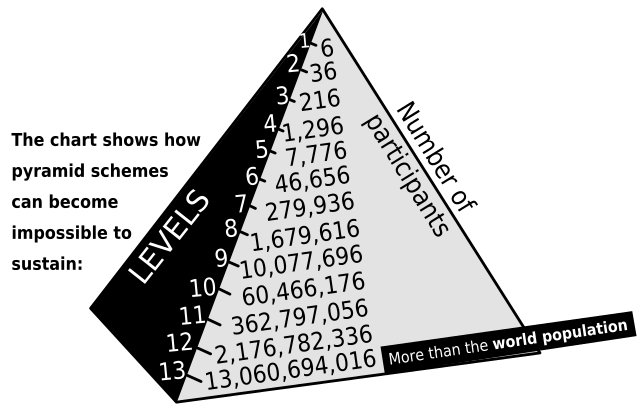
Source: Wikipedia
As you can see, in this pyramid model it’s required to recruit 6 people. You’ll notice from the 12th level and further, it’s not possible anymore for everyone to earn money.
The 2.2 Billion people on the 12th level need 13.1 billion recruits in total for them all to make money which is more people than there are currently on Earth.
At the point that people can’t be recruited anymore, the pyramid collapses because not enough money is coming in to pay members and sustain the pyramid.
Looking at the description of what a pyramid scheme is, Shaklee can’t be classified as a pyramid scheme from a legal perspective. Shaklee products have given people a method to make money without recruiting people.
That being said, there are pyramid schemes that disguise themselves as MLM companies because MLMs also use a pyramid structure but sell products and services.
John M Taylor. a prominent figure in the research of MLM’s and Pyramid schemes calls these product-based pyramid schemes.
He came to the conclusion that this variant is a lot more dangerous than its predecessor.
A few examples of these can be found on the FTC website, such as Vemma an “MLM/Direct-selling company” that supposedly was selling liquid nutrition products but turned out to be a pyramid scheme.
Ultimately they settled and had to pay a fine of $238 million and were suspended from partaking in recruiting practices to distribute their products.
These pyramid schemes offer products that are almost impossible to sell with the goal of pushing you to recruit people because you supposedly can get higher commissions.
These pyramid schemes bring in money by the members paying for a membership and them purchasing products thinking they’ll earn money in the long run.
In an investigation by the FTC regarding Amway, a precedent was set called the 70 percent rule.
They were accused of being a pyramid scheme.
The 70 percent rule states that every distributor must sell at wholesale and/or retail at least 70% of the total amount of products he bought during a given month in order to receive the Performance Bonus due on all products bought.
This was set in order to prevent distributors from purchasing their way to the top and the company from earning money at the expense of the distributor.
This is of course hard to prove so most of the time to spot a pyramid scheme people look for signs in which the company encourages recruiting while discouraging selling products.
From that point on it’s the same as a traditional pyramid scheme but is this the case with Shaklee?
Let’s see if we can find some red flags by looking at the income statements, costs, compensation plan, and more to draw a conclusion.
READ THE NEXT BLOG POST:
There are 5 most occurring red flags present in pyramid schemes.
1. Recruiting of participants is unlimited in an endless chain of empowered and motivated
recruiters recruiting recruiters.
2. Advancement in a hierarchy of multiple levels of “distributors” is achieved by recruitment,
rather than by selling products and services.
3. Ongoing purchases (products, sales “tools,” etc.) by “distributors” are encouraged in order
for them to be eligible for commissions and to advance in the business (“pay to play”).
4. The company pays commissions and/or bonuses to more than five levels of “distributors.”
5. For each sale, the company payout for each upline participant equals or exceeds that for the
person actually selling the product.
Let’s review their compensation plan, income numbers, earning potential, costs, and more to see if we can uncover some red flags.
Shaklee products
What are the products they sell?
Since the founder of Shaklee produced the first multi-vitamin you won’t be surprised when I tell you that they sell vitamins but they do sell some more products. Shaklee divided their products into 3 categories:
- Nutrition
- Personal care
- Home Products
Nutrition
The nutrition products mostly consist of vitamins and minerals, protein shakes and powder, weight loss products, and other nutrition products related to these subcategories. Most of Shaklee’s best sellers are from this category.
Personal care
Personal care products are offered in the form of anti-aging products, moisturizers, body lotions, serums, men’s grooming products, cleansers, exfoliators, and more.
They do seem to be more on the expensive side but I haven’t seen a lot of low user ratings when it comes to the personal care products.
Home Products
Household cleaning products, dishes, towels, water filtration, and commercial cleaning products. Aside from the water filtration system, these are pretty ordinary products you can find in any store.
You’ll notice that these are also a bit more expensive than in most stores that don’t rely on network marketing to distribute their products.
Are Shaklee products FDA-approved?
The majority of Shaklee products consist of vitamins. None of these vitamin-related products are evaluated by the FDA. You can go to every product page on the website and you’ll see a statement about that the products aren’t approved by the FDA.
Personal care and home products don’t fall under the type of products that the FDA evaluates which means the rest of the Shaklee products aren’t relevant when it comes to FDA approval.
Are Shaklee vitamins safe?
Shaklee vitamins get tested a lot and were involved in multiple clinical studies. That being said, they were all done by independent laboratories so I can’t guarantee there was no bias playing a role in their test results.
What does bode well for the products is that they’re used by some of the most notable organizations such as NASA and Olympic teams. That says a lot in my opinion.
Are Shaklee products aligned with the market?’
The Shaklee products seem to be a lot more expensive than its non-mlm-related competitors.
The price can have a lot of influence on your success as an ambassador. Selling vitamins is hard when people have cheaper alternatives with a 2-minute Google search.
This is also validated by the fact there are a lot of people selling Shaklee products in bulk on Amazon for a lower price than the wholesale price offered to ambassadors.
I suspect these are people trying to unload products they couldn’t get rid of.
Shaklee Compensation Plan
Shaklee is very similar to a traditional MLM when looking at its compensation plan.
How much money you’ll earn is heavily based on your ranks which you receive by meeting Shaklee’s compensation plan qualifications.
There are three factors to meeting qualifications:
- Personally purchase (or resell) enough product volume to qualify
- Recruiting enough customers (who become your downline) to qualify at your desired level.
- Your downline purchasing (or reselling) enough products.
You’ll receive different types of points (personal volume, customer volume, team volume, etc.) for doing these actions. What type of points you get can differ.
Here you can see the qualifications for each rank and the residual income they get for every level.
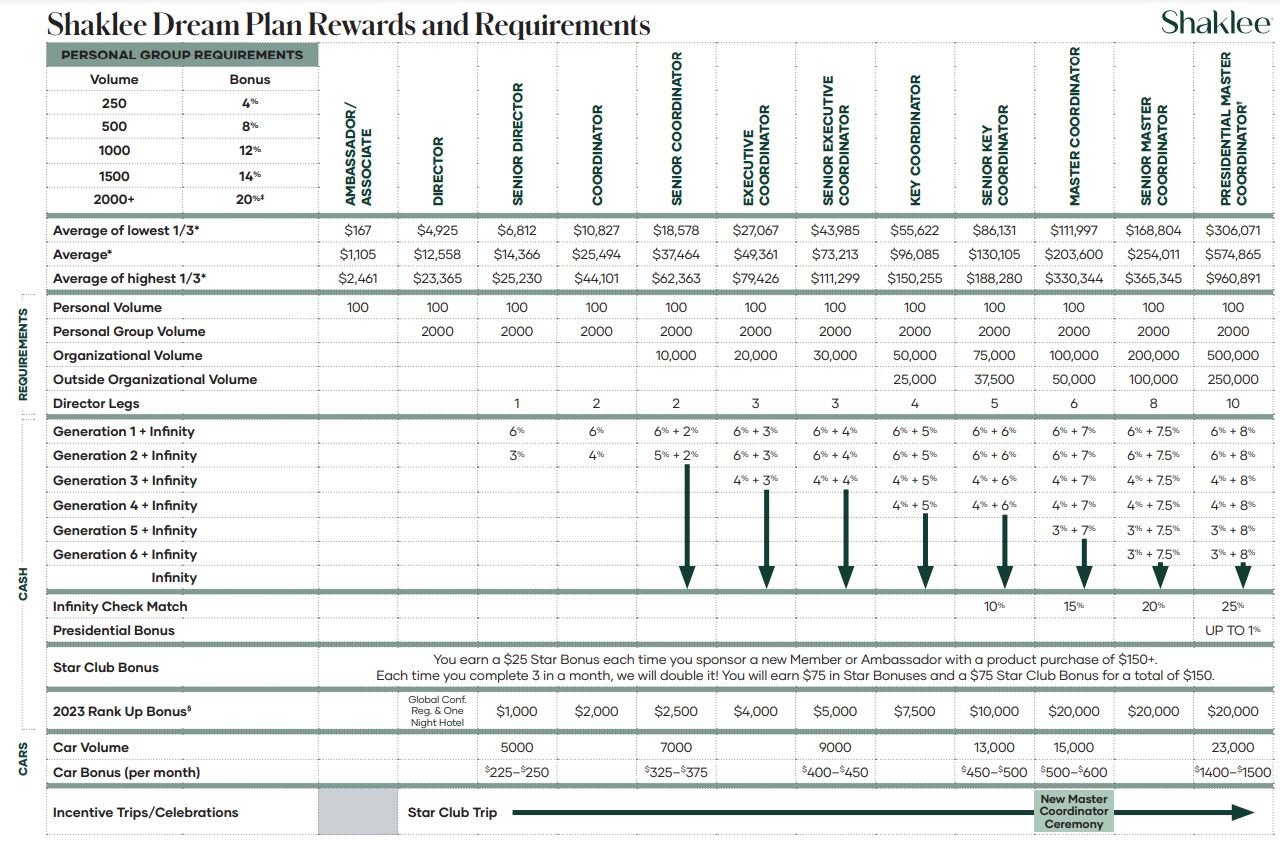
Shaklee does off the ability to solely resell products to earn money but to your maximum earning potential, you’ll have to start recruiting.
How much does it cost to start a Shaklee “business”?
Like most MLM companies, you’ll have to make a financial investment to join as a Shaklee ambassador.
How much you’ll have to pay differs per country.
For this post, I mostly focused on what it’d be like if you joined Shaklee in the United States of America but most countries seem to be around the same price range.
When you sign-up you’ll have to buy an enrollment kit.
There are multiple enrollment kits available but the cheapest and basic pack is the business Start kit ($49,95).
This kit contains documents to keep up to date with what is going on with Shaklee, website tools, business management tools, and some samples.
To kick start your journey you also have to purchase 100 points (PV) worth of products.
At the lowest level, you’ve to at least purchased 100 points for products every month.
So that’s 100×12= 1200 Personal Volume a year you have to invest as a Shakleee ambassador at the lowest level.
100 PV doesn’t say much on its own because most MLMs decide for themselves how much 1PV is worth.
Luckily, we can use the boosters as a reference to figure out the costs on a monthly and yearly basis.
A great example of a product that’s worth 100PV is the Ready Set Wellness Bundle with Vitalizer.
As a booster choice, it’s $179 including the discount you get as an ambassador.
This means in a year you’ll spend 12 x $179 = $2.148 + $49,95 => $2.197,95 as an ambassador.
Can you earn money with Shaklee?
In theory, you could make an average of more than a million-dollar per year according to their income disclosure statements but what is the chance of you getting to this point?
Let’s take a look at the most recent income disclosure.
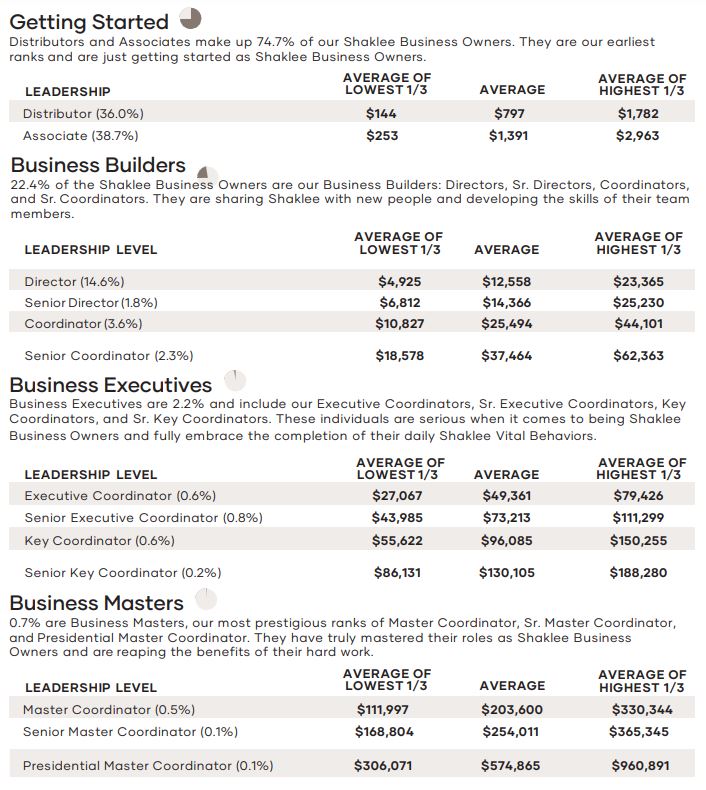
Key takeaways from looking at the income disclosure:
The turnaround rate for new ambassadors is extremely high
74,7% of the business builders are in the lowest ranks according to this income disclaimer. They also state in the document that these people are just starting with building their businesses.
+70% quitting after having placed their initial investment + the 100PV needed to be eligible for commissions isn’t a good look.
97,1% is earning less than the median US Full-Time income
Earning a full-time income with Shaklee isn’t something that occurs often even if we just look at the average income numbers that include outliers that earn a lot. The median US income is around $30.000 which the majority of ambassadors aren’t getting close to.
The majority of ambassadors lost money
On average, almost 75% invested more money in the Shaklee “opportunity” than they earned.
The earning potential of Shaklee seems to be low based on what current ambassadors are earning.
READ THE NEXT BLOG POST:
Why aren’t people earning decent money with MLM companies like Shaklee?
I have summed up the reasons why it’s hard to make money with Shaklee and MLM companies in general into 3 points. As a Shaklee ambassador, you’ll have to deal with the 3 points mentioned below.
1. MLM companies are often associated with pyramid schemes
MLMs have a pyramid recruiting structure that you often have to join to be able to make decent money or at the very least not lose money.
The problem is a lot of pyramid schemes disguise themselves as MLM programs making it difficult to differentiate the two. This is the biggest problem why most distributors have a difficult time recruiting people.
The moment people hear about how you can make money by recruiting people red flags appear in most people’s minds.
This isn’t good for your sales.
2. You have to consistently invest your money to earn commissions
You’re only eligible for bonuses and commissions if you buy their products. The bigger the bonuses, the more product you have to buy.
You do get discounts but if you can’t sell the products I can see you easily fall into a financial deficit (which happens to the majority of distributors of MLM companies).
3. The price of the product often isn’t aligned with the market
It’s hard for a multi-level marketer to sell products because most MLM products tend to be a lot more expensive than similar products sold by non-MLM companies.
This means even if you’re really good at recruiting your downline still needs to sell those same expensive products for you to make decent money.
You can see that translated in these statistics I found about Multi-level Marketing.
- Nearly half (47%) of MLM participants reported that they lost money.
- One in four (27%) MLM participants reported breaking even (made no money).
- MLM participants are 7% more likely to declare bankruptcy during their lifetime.
- Direct sales have risen 79% in the last decade, but MLM participants continue to lose money.
- 90 – 99% of distributors in multilevel marketing only receive a couple of hundred dollars in commission per year.
- Out of the 33,000 interviewed, 90 people made enough money to cover the costs of building their businesses.
- 50% of the people who start a network marketing enterprise abandoned it in the first year.
Sources:
FTC
AARP
Jobsinmarketing.io
Conclusion: Is Shaklee A Pyramid scheme?
Let’s go over the red flag with everything I’ve shared with you about Shaklee.
1. Is there an endless chain of recruiters being encouraged to recruit other recruiters?
People are being encouraged to keep recruiting to increase their earnings. That being said, most bonuses don’t require you to recruit ambassadors they have to recruit people as well.
You can get most of the same bonuses by recruiting members that are only interested in personal purchases.
2. Does rising up the ranks require recruitment rather than sales?
Recruitment is necessary but the number of people in your team doesn’t influence your rank. It’s more dependent on the performance of the team you have after a certain point.
3. Do you have to pay to play?
You have to invest financially before you’re eligible to earn commissions. Dependent on the products you “accumulate” to reach the minimum quota of 100PV per month you’ll have to invest roughly a minimum of $2000 on a yearly basis.
4. Does Shaklee pay commissions and/or bonuses to more than five levels of “ambassadors.”
Yes. Their compensation plan allows people to earn residual commissions 6 generations deep which often isn’t a good sign when it comes to dispersing the money through the company.
5. Does the upline receive more money for every individual sale from his downline than the person making the actual sale?
After doing a deep dive into the compensation plan, I don’t see any signs of the upline earning on an individual sale made by ambassadors in their downline.
It checks the boxes for 3 out of the 5 most occurring red flags pointing at a pyramid scheme but the 2 most important red flags (recruiting over sales) don’t apply to Shaklee.
Shaklee seems to be a legitimate MLM but can’t be considered a financial opportunity when you look at how much people are earning according to their income disclosure.
READ THE NEXT BLOG POST:
Conclusion: Is Shaklee A Scam?
Shaklee isn’t a scam and isn’t making any untruthful statements about changing your lifestyle by becoming a Shaklee Ambassador.
The only thing that rubs me the wrong way is that they present the numbers in such a way as to make it seem better than it actually is which isn’t illegal but a bit sketchy, especially when you’re encouraged to recruit people in what I’d call a failing business model (for its members).
Showcasing the median income instead of the average would truly give an accurate look at how much most people are earning. These 2 can differ a lot but at quick glance, it’s likely a reader won’t think about that and join without having proper knowledge.
Shaklee Alternative
Unfortunately, Shaklee might not be the ideal method for earning money.
It comes with significant financial risk and you’re fighting against the reputation of the business model every sale.
This is why I suggest an alternative to those who don’t want to deal with these 2 factors.
It is called affiliate marketing.
It’s the method I use to earn most of the money I earn online.
How do you earn money with affiliate marketing?
You don’t have to sell products or services and you don’t have to recruit people.
The only thing you’ll be doing is referring people (that already are interested) to merchant websites such as Amazon, Walmart, and eBay.
When people buy something based on your recommendation you’ll get a percentage of the purchase.
My #1 recommendation is an affiliate marketing training platform with more than 1.5 million members.
Memberships are basically an all-in-1 package that comes with expert-level training, resources, and support from a community of people doing the same thing.
Want to learn more? Take a look at my comprehensive review of the affiliate marketing platform.
Do you have any experience with MLM or Modere let me know in the comments!
That’s all for today.
See you in my next post!
READ THE NEXT POST: 3 WAYS TO EARN MONEY ONLINE TO ESCAPE YOUR 9 TO 5 JOB

